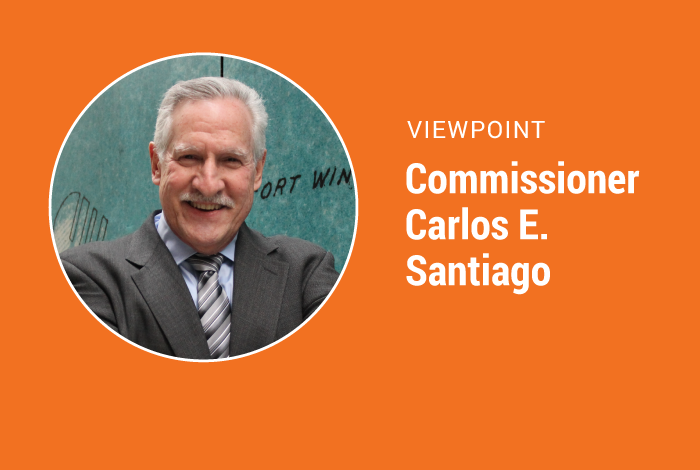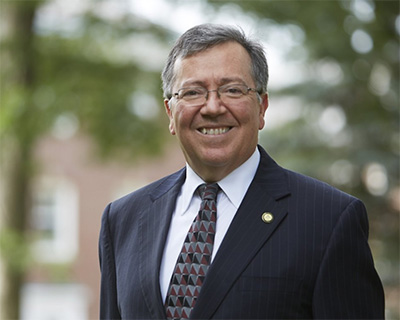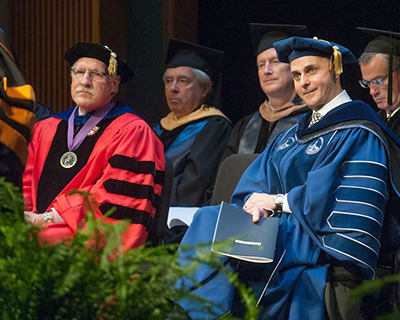
September 16, 2016 Remarks to Members of the New York State Assembly and SUNY
The issues of diversity and inclusion are already shaping the way institutions of higher education operate and how they respond to various stakeholders. Calls to enhance representation reflect a dramatic demographic shift that is playing out in a number of different areas. Our politics, our social contracts, and notions of civil society are particularly changing in response to these new demographic realities.
I approach issues of diversity and inclusion from various different vantage points—as a student in institutions that were predominantly white with few Latino students or faculty, as an academic researcher trying to create intellectual spaces for emerging disciplines, as a department chair, a dean, a provost, a chancellor, and now the head of a public higher education system. In each instance and circumstance, I understood the value of diversity and inclusion—it simply made whatever we were engaged in better. The conversations were better, the policies more robust, and the outcomes and impact more widespread. My direct experience has taught me that a more diverse institution, at all levels, makes for a better institution. But, as I will discuss a bit later: Diversity is necessary for institutional excellence but it is not sufficient.
In 1970 being a Hispanic student (that was the term the federal government used to identify us at the time) represented ‘otherness’ in many different respects. We were few in number, there were no cultural markers to identify within mainstream institutions, and we had virtually no role models. For Puerto Ricans it provided other contexts which complicated our sense of identity. Puerto Ricans are a truly diaspora population, flowing readily between the continental United States (predominantly New York City) and the Island. We were literally caught between multiple worlds. You were stereotyped one way if you grew up in New York and another if you grew up in Puerto Rico. “Where is home” was always a source of discussion and contention for many Puerto Ricans.
A campus whose senior leadership is devoid of diversity will struggle to understand what motivates the current demands of students. They will be unprepared for the future.
I was clearly not immune to these developments growing up as I moved 8 times between the ages of 3 and 16. Puerto Ricans were often measured by skin color, phenotype, and language acquisition (read accent). Stereotypes follow all of us. While Puerto Rico was generally perceived as the country of origin, even then, Puerto Ricans born or raised elsewhere did not hold the same status on the island as those who never experienced the diaspora. I tell you this because we are fundamentally shaped by our experiences through the life cycle. It colors how we see the world and how we navigate through it.
The prism of our experiences helps us understand today’s college student movements and the continuing demand for space and inclusion. A campus whose senior leadership is devoid of diversity will struggle to understand what motivates the current demands of students. They will be unprepared for the future. Even during my time in Milwaukee, a minority-majority city plagued with decades of inequality and struggling to adjust to de-industrialization, it was imperative that I better understand the realities of life in that city from multiple perspectives if I was to move the university forward. As Chancellor I made mistakes just as others did, but surrounding myself with individuals who understood the nuanced realities of that city helped minimize mistakes and promoted positive corrections along the way.
My student experience helped me immensely as I entered the academy and made my way up the academic ranks. This became particularly clear to me as I was selected to be department chair of an interdisciplinary ethnic and area studies program. I left my home department of economics (I thought temporarily) to head up a small, dedicated group of scholars. There had been some controversy prior to my arrival since the faculty had changed the department name from the Department of Puerto Rican and LatinAmerican Studies to the Department of Latin American, Caribbean and Latino Studies.

Diversity and inclusivity was our guide to create a high quality academic department. We expanded joint appointments across the university, recruited the best graduate students we could find, and created a supportive environment. For the Latino faculty and other faculty that gravitated to us, the department was referred to as an ‘oasis’. But the challenge was how to increase the number of Latino faculty in a typical environment of scarcity and competing priorities.
We were fortunate to have at that time a visionary president at the University at Albany, H. Patrick Swygert, later to become president of Howard University. He asked me to continue my academic and administrative work and to append the title of ‘Special Assistant to the President’ to the things I had been doing. As an aside, I knew that the university had just been dinged in a Middle States accreditation review for having an insufficiently diverse senior leadership team. I could have rejected the appointment believing that it might have been a token assignment. But Pat really saw this as a great opportunity for positive change and he was quite right. My charge was to help diversify the faculty and graduate student ranks, particularly to add more Latino faculty. One instrument that he asked me to use was something called the Target of Opportunity Program. The idea behind the program was that in the midst of a faculty search you often found a qualified Latino candidate yet, invariably, that person often was not selected and the rationale often given, not entirely unreasonable, was that that candidate was not in the field or area that they were looking for.
So the president gave us the authority to go back to the department to say, “Okay, hire your first choice candidate in the field you desire but if you feel that a minority applicant is highly qualified, yet in an unrelated field, hire them too—and we’ll pay for it, at least for the first three years.” The institution made progress under that model but I am afraid that I stretched the rules a bit. When a department chair would tell me that they had no Latino candidate or finalist for a position (and that was often) I would ask them to review resumes I provided and if a candidate intrigued them, to bring him or her in for an interview. This approach was a bit out of the ordinary. So the faculty in the department began using their academic networks to identity exceptional Latino faculty from across the country. And the one condition we required was that they have a joint appointment with our department. That is how an ethnic and area studies program acquired its first Latino biologist. We knew that this approach could be, and eventually would be challenged but we pursued it for as long as we could. It made a huge difference as the numbers of Latino faculty continually grew. For us, we were singularly focused on increasing the number of Latino faculty at the University at Albany. And by and large, it worked.
As the department grew from 15 to 24 faculty members, we deliberately used this strategy to provide an environment that helped young faculty survive and thrive. It was not enough to bring qualified faculty to the campus, we had to retain them and help them up the academic ranks. Mentorship was a necessary ingredient.
It was not enough to bring qualified faculty to the campus, we had to retain them and help them up the academic ranks. Mentorship was a necessary ingredient.
At the same time, we were in a full-fledged fight with our national disciplinary colleagues. The world of area and ethnic studies was in a clash. Latin American studies and Latino studies were at odds in a number of ways but the former was the established discipline and the latter the new upstart. Our basic premise was that to understand the experience of Latinos in the United States you also needed to understand their countries of origin. We fought to have a voice in national and international organizations—today that fight for space is old news and the disciplines coexist. In the ‘80s and ‘90s it was a different story. We began establishing and expanding professional organizations that focused on Latino studies. The Puerto Rican Studies Association was so founded during this time and continues to this day, creating a pipeline of talent. Journals and professional associations with Latino(a) in the title began to flourish across the country. These networks were important in the growth, retention, and advancement of Latino faculty across the nation.
We were always deliberate and intentional in what we did. The creation of a professional organization in the discipline was not only to sponsor conferences, scholarship, and publications, it was to identify, mentor, and support young scholars who were actively engaged in a variety of different established disciplines. Historians, psychologists, and even economists began looking at their disciplines from the prism of the Latino experience. This was not only empowering; it created a more inclusive scholarship as well. Fundamentally, it was to create a cadre of academics with similar scholarly pursuits. We were not a homogeneous organization that thought about everything the same way, or only included those we worked with personally. It was about creating a safe space for intellectual growth without the fear that someone would be ostracized by what they said or did in academic terms. It morphed into a recruitment and retention vehicle for Latino scholars, building a culture of excellence and inclusion and giving voice to those that did not have it.


After President Swygert left for Howard University, I steadily moved up the academic/administrative ranks to become Provost and Chief Operating Officer of the campus. Diversity remained an important focal point of campus leadership. However, now my attention was on diversifying the decanal ranks. Of the eight deans that reported to me at the time only one was female. She was exceptional and she happened to be dean of the libraries, a position that was commonly held by women. By the time I departed four years later, the decanal ranks consisted of 4 female deans and four male deans. And women were now heading up the largest colleges on campus, including the College of Arts and Sciences. The level of discussion and the camaraderie, I felt, had moved to a higher level. To accomplish this we required a diverse pool of semi-finalist for every senior position or, quite frankly, we would threaten to close the search down. We never had to resort to this. This posture and this experience served me well as I went to the University of Wisconsin-Milwaukee.
As a system head, the ability to institute comprehensive change is often limited by the authority that one possesses. I am intimately involved in all the presidential searches throughout the process—from approval of the list of semi-finalists to interviewing all of the finalists. My authority allows me to veto any finalist selected by the local boards but I cannot select a candidate that the local board has not approved. I have never invoked my veto authority in presidential searches.
Until recently, Massachusetts had never had a Latino president at a public institution. The first presidential search committee I served on when I came to Massachusetts was in 2014. I served on the search committee in my role as CAO and as the Board of Higher Education’s representative to the committee. The committee selected a sitting president from Pennsylvania, Dr. Javier Cevallos, as the President of Framingham State University and the first Latino president of a public institution that anyone could remember. He is doing a phenomenal job. As Commissioner I oversee all of the presidential searches and last year we selected our second Latino president, Dr. Ramon Torrecilha, at Westfield State University. He came to us via California.
To diversify a department, school, or university requires a true commitment. For some of us it is a lifetime commitment.
So, why have I taken you down this memory lane? The reason why I felt it important to frame my remarks in this way was to highlight that the intent to diversify a department, school, or university requires a true commitment. For some of us it is a lifetime commitment. I have moved institutions from Research 2 to Research 1 status, I have helped create new schools such nano sciences in Albany, public health and freshwater sciences in Milwaukee, and built programs of excellence. But to truly create a diverse institution that goes beyond the numbers and engenders an inclusive environment is the hardest job any university president has to tackle. As difficult as it is, my message is that the benefits are multiple and the risks of not doing so are significant.
Being a university president today is quite difficult today—perhaps the most challenging job that exists. We have a business model that is not well equipped to handle the democratization that diversity requires. Funding for our public institutions is variable. The support needs of today's students are significant. Small, enrollment-driven institutions, both public and private, are vulnerable. Deferred maintenance costs run into the multiple billions of dollars. Issues of violence and sexual assault are now front and center on our campuses. And conversations about social issues have become increasingly contentious—a true reflection of our society.
All of these challenges call us to change the way our institutions function and how we treat our students, staff, and faculty. We may not be able to control societal forces but we can create better and more diverse organizations to cope with them.
I applaud the New York State legislature and SUNY for their willingness to engage in this important conversation. Thank you.